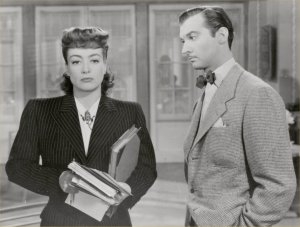Mildred Pierce
|
|
Mildred Pierce is
- a novel (1941) by James M. Cain; and
- a feature film (Michael Curtiz; US, 1945) starring Joan Crawford which is based upon this novel.
The novel
Mildred Pierce, which is set in and around Los Angeles in the 1930s, depicts the life of an American self-made businesswoman. Frustrated by her unemployed, penniless, apathetic and fatalistic husband, Mildred Pierce, despite the Depression, sets out to realize her own American Dream by becoming the breadwinner of the family - she bakes beautiful and delicious cakes for the people in their neighbourhood - and, soon afterwards, by ejecting her unfaithful husband and caring for their two daughters as a single mother, regaining her self-esteem on the way. After trying her hand at all kinds of jobs, including waitressing, she finally succeeds in opening her own diner and very soon is the proud owner of three restaurants. An attractive young woman who believes she is entitled to some spare time and fun as well, she starts an affair with Monty Beragon, the impoverished owner of a California-based fruit company.
After her young daughter Kay has died of some infection, Mildred focuses all her love on her one remaining child, Veda. Arrogant and haughty, Veda basks in her motherīs success but increasingly turns into an ungrateful child, demanding more and more from her hard-working entrepreneur mother without contributing anything to the family income herself. Rather, she starts training, and eventually performing, as a singer, a fact which, although it makes her mother proud, also costs an awful lot of money.
Events head toward a sad climax when 17 year-old Veda tries to get money out of a wealthy family by alleging that she has been made pregnant by their son. Only gradually does it dawn upon Mildred what a nasty character Veda has developed, as her daughter has not only had pre-marital sex but as she has done so out of greed rather than love. When subsequently Veda lets herself be seduced by hedonistic Monty Beragon - Mildred catches them almost in the act in Monty's bedroom, with Veda getting out of bed stark naked - Mildred finally realizes her inability to continue their mother-daughter relationship. Veda and Monty go away to New York together, Veda leaving her mother for good, finally able to get away from "everything that smells of grease". At the very end of the book Mildred makes up with her somewhat reformed husband, and the reunited couple wish their daughter to hell.
The movie
The most astonishing fact about Curtizīs film adaptation is that it was designed as a thriller. For that reason, a murder was introduced into the plot.
Whereas the novel is told by a third person narrator in strict chronological order, the film uses voice-over narration (the voice of Mildred). Most of the action is set at the local police station, which serves as a frame, where Mildred has been brought for questioning after a suicide attempt. (It seems she wanted to throw herself into the sea.) She tells her whole story in a series of long flashbacks up to the point where, right there at the police station, she faces Veda, who, as it turns out, has shot Monty Beragon because he has insulted her and told her he has no intention of eloping with her. This is the point where Mildred can no longer protect her daughter, where Veda has to take responsibility for her own actions for the first time.
According to Jim Hitt (Words and Shadows. Literature on the Screen [New York, 1992]), "the Mildred Pierce (Warner Bros., 1945) of director Michael Curtiz is not the Mildred Pierce of author James Cain, and Cain didn't like it". However, the movie is "a superior example of film noir, improving the novel on several counts". William L. DeAndrea (Encyclopedia Mysteriosa. A Comprehensive Guide to the Art of Detection in Print, Film, Radio, and Television [New York, 1994]) briefly states that "a murder that doesn't appear in James M. Cain's novel was added to the film, thereby moving it into the genre."
Some of the other changes that were made - an inexhaustive list:
- The material is condensed, the story is tightened and updated, the pace quickened, time is constricted:
The novel spans a period of nine years (from 1931 to 1940), whereas the action of the film is set in the 1940s (cars!) and spans only four years. Accordingly, in the film, the characters do not really grow older: Mildred does not change her appearance, she does not put on weight and become matronly; Veda does grow older though, but only four years, from around 13 to around 17. Generally speaking, Mildred is more of a tycoon in the film. Her restaurants are glamorous places, and she owns a whole chain ("Mildred's") rather than just three.
Also, all references to the Depression and the Prohibition era were removed.
- The plot is simplified and the number of characters reduced:
Veda_and_Mildred.jpg
Image:Veda_and_Mildred.jpg
Ann Blyth as Mildred's ungrateful daughter Veda
For example, the part of the action which revolves around Veda's training and success as a singer (including her performance at the Hollywood Bowl) was dropped altogether. Obviously, Veda's music teachers do not appear in the movie version.
Mildred's numerous staff - both at home and at her restaurants - are represented by one (!) young and rather pretty African American housemaid (stereotyped as slightly dumb and thus comical) who also seems to be helping out at the restaurants.
- The depiction of sexuality is softened (in accordance with what was both legal and acceptable in movies at the time; see Production Code / Hays Code).
The film has been deemed "culturally significant" by the Library of Congress and selected for preservation in the United States National Film Registry.

